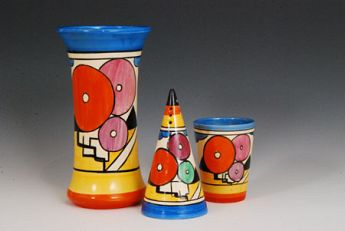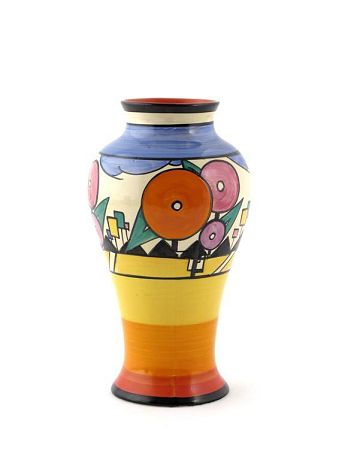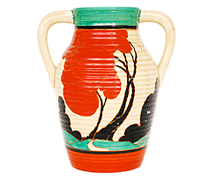Clarice Cliff Feature Articles
Geometric Garden was probably introduced in 1930* and appears to be a hybrid design with elements from the early geometric and landscape designs. Looking at Geometric Garden you can see elements of Luxor, Circles & Squares (Allsorts), Sunray, Geometric Buttons and Geometric Flowers. However, this is a landscape barren of the usual Clarice elements. No cottages with reassuring smoke coming from the chimneys or sinuous trees in the foreground. This is a landscape of uncompromising geometric shapes – circles, triangles and rectangles. I was unaware of it as a pattern until I saw a Mei-Ping vase come up for sale in Christies in the 1990’s. Those of you who went to Olympia may have seen the same vase for sale.
Because of its rarity (perhaps it was limited to one batch being painted?) the pattern seems to be consistently outlined but interestingly there appears to be some difference in the way the pattern was coloured and elements omitted. There appears to be two distinct variations. The beaker, conical sifter and vase have the ‘leaves’ and square flowers omitted (see above). However, the drum preserve, Mei-Ping vase and Daffodil shape 450 bowl have these elements. Is it possible these were two distinct variations of the pattern, or were these elements just omitted? A fellow collector has suggested that perhaps the heavily decorated versions were just too time-consuming, hence the omissions. Although this may have been a trial batch, utilitarian items were also decorated in addition to decorative items, such as the vases. The ‘exception’ to the rule is the plate donated to MOMA by Susan Pear and Louis K. Meisel in 1982. It has the leaves but no square flowers or a round flower in brown.
Shown next is a beaker, which I believe to be a very early production example. It is very well painted and has either a paintress’s initial ‘S’ or a mark identifying it as a ‘sample’ to the base.
Next is a shape 205 8-inch high vase. This is painted with the same colours as the beaker above and both appear to have been executed very carefully. I have also shown the Bizarre mark to the base of the vase.
Pictured next is a conical sifter in the pattern. Here, the colour palette has altered: the smaller flower has been changed from purple to green. This colour change balances the design making it look more dramatic. On all the pieces of Geometric Garden I have seen the banding remains the same with the exception of the conical sifter where the banding has been reversed and the introduction of black on the tip, instead of red.
Next is a drum preserve pot as we call it these days but in the 1930’s was known a “covered honies” which came in three sizes – 2-1/2inches, 3 inches and 4 inches - which in my view is the best painted of the group. It has all the elements of the design repeated twice. It is executed perfectly and seems the perfect shape and design combination. If I were to own a perfect example of this pattern the preserve pot would be the one.
Finally we have a Daffodil shape 450 bowl in Geometric Garden. At first it seems at odds to have an Art Deco pattern on an Art Nouveau shape. However the shape and pattern combination seems to work. This has been achieved by the paintress using the banding colours seen on the other shapes, used on the fins of the bowl.
In this article I have documented at present ALL known examples of Geometric Garden. No doubt others will appear and you might have a piece in your collection. If you have I would love to know about it so please drop me a line at caseygavin@hotmail.com and post any information and photographs you may have on www.claricecliff.com.
.
Gavin Casey
Edited by Doreen Mann
* Clarice Cliff by Will Farmer, Shire Publications 2010








